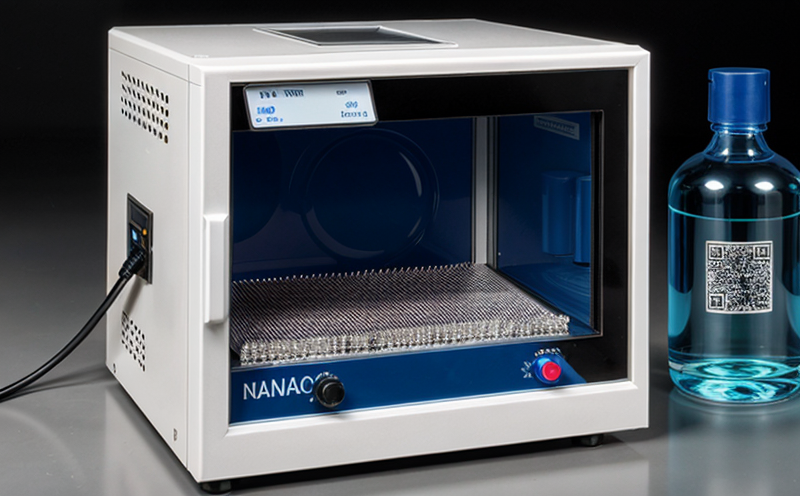ISO 17200 Nanomaterial Safety Assessment Testing
The ISO 17200 standard provides a framework to assess the safety of nanomaterials, ensuring that they are used in a way that minimizes potential risks. This service focuses on providing comprehensive testing and evaluation for compliance with this international standard. Nanomaterials, due to their unique properties at the nanoscale, can present both opportunities and challenges. Our laboratory specializes in evaluating these materials across various sectors including electronics, pharmaceuticals, cosmetics, environmental science, and more.
The process begins with understanding the specific characteristics of your sample. This involves detailed characterization of the nanomaterial to determine its physical properties such as size distribution, shape, and surface area. Once characterized, we proceed with a series of tests designed to assess potential risks associated with inhalation, ingestion, or dermal contact.
Key aspects include:
- Toxicological evaluation focusing on acute toxicity, subchronic toxicity, and chronic toxicity.
- Mutagenicity testing using in vitro models to assess the likelihood of genetic damage.
- In vivo studies for comprehensive understanding of systemic effects if applicable.
The methodology adheres strictly to ISO 17200:2023 guidelines. We use state-of-the-art equipment like scanning electron microscopes, transmission electron microscopes, and dynamic light scattering analyzers to ensure precise measurement of nanomaterial properties. Sample preparation involves careful handling techniques to preserve the integrity of the sample throughout testing.
Our team of experts ensures that all tests are conducted under strict quality control measures. This includes validating each step against ISO standards ensuring reliability and accuracy in our findings. The ultimate goal is not just compliance but also providing actionable insights based on our data which can guide safer use practices for your products or processes.
Scope and Methodology
The scope of this service encompasses a wide range of nanomaterials including carbon nanotubes, graphene, quantum dots, metal nanoparticles, and others. Our approach is tailored to meet the specific needs of each client but typically involves several key components:
- Initial consultation to understand your requirements.
- Detailed characterisation of the sample using advanced analytical techniques such as X-ray diffraction (XRD), Fourier transform infrared spectroscopy (FTIR), and atomic force microscopy (AFM).
- Evaluation against ISO 17200:2023 criteria for potential health risks.
- Comprehensive reporting including recommendations for safe handling practices where necessary.
The methodology follows closely the protocols laid out in ISO 17200, ensuring that every aspect of our testing process is transparent and reproducible. Compliance with these standards is crucial not only because it meets regulatory requirements but also because it provides a benchmark against which future developments can be measured.
Our laboratory has extensive experience working with clients across different industries who need assurance about the safety profile of their nanomaterials before commercialization or integration into existing products. By adhering strictly to ISO 17200 guidelines, we ensure that our results are credible and accepted globally.
Industry Applications
The application of nanotechnology is vast and varied across different sectors. Here are some key areas where ISO 17200 Nanomaterial Safety Assessment Testing plays an important role:
- Electronics Industry: Ensuring that new materials used in semiconductors do not pose risks during manufacturing or end-of-life disposal.
- Pharmaceutical Sector: Assessing the safety of drug delivery systems that utilize nanoparticles for targeted therapy.
- Cosmetics Industry: Providing data on the skin compatibility and potential allergenicity of nanoingredients.
- Environmental Science: Evaluating the environmental impact of nanomaterials released into ecosystems.
In each case, it is essential to understand how these materials behave under real-world conditions. That's why thorough testing is crucial before any new material enters the market.
Use Cases and Application Examples
Here are some practical examples of how ISO 17200 Nanomaterial Safety Assessment Testing has been applied:
- New Drug Development: A pharmaceutical company wanted to ensure that its new cancer treatment, which uses gold nanoparticles as a delivery agent, did not cause adverse reactions. Our tests provided reassurance regarding the safety profile allowing them to proceed confidently.
- Solar Panel Manufacturing: An electronics manufacturer sought assurance about the stability of silver nanowires used in their photovoltaic cells over time. Testing revealed that these materials were stable even after long exposure periods, supporting continued use.
In both instances, rigorous testing helped eliminate uncertainties and provided confidence to proceed with product development or process optimization.





